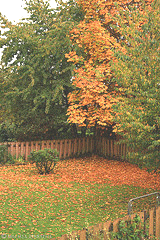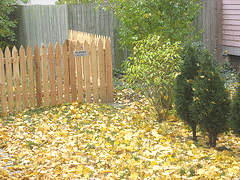Prepare the Lawn for Winter
You need to keep your grass healthy and actively growing through summers’ heat and right up until autumn in order for it to sustain good turf cover. As we get into autumn, the days and nights are cooler and there is often more rain to offset a dry summer. You should be able to cut back on your watering as fall rain moves in.
Assuming you kept your grass it bit longer to get through a hot summer, probably about 2 1/2 or even 3 inches, you can start to lower the blade gradually, reaching 1 1/2 inches by the last couple of times you mow. Where snow cover is heavy, shorter grass will help reduce matting, that may contribute to snow mold. If your lawn is yellowing by the end of August or beginning of September, it needs more nitrogen to stay healthy. If you were able to get a midsummer application of fertilizer down before a rare rain, you can probably wait and do a “winterizing” application.
Early September is a great time to put down an appropriate fertilizer. Or wait until the grass has gone dormant and is no longer growing, it will be waiting in your soil next spring. Winterizing fertilizer benefits our cool season grasses like fescue and bluegrass, and ensures a green and healthy lawn when spring emerges. A good formula is generally a bit lower in Nitrogen, and higher in Phosphorus and Potassium. The Nitrogen will aide in root development and keep the grass healthy (green!), but a lower dose than early applications keeps it from growing like crazy when we want it to start winding down. The Phosphorus encourages roots to store energy, however most regions have banned Phosphorus from fertilizers other than for new sod or seed, where the root development is most important. Potassium will help protect against the cold weather coming. 22-3-14 are the N-P-K numbers you should look for. Water well after application if rain is not expected. If you are far enough south (mid Alabama and south) that your lawn is bermuda, centipede, zoysia or St Augustine grass, winterizing fertilizer will do more harm than good as the grass needs to go dormant.
The cooler, wetter weather of fall encourages plants to grow again, including weeds. Since actively growing is important for broadleaf weed controls to work effectively, this is a great time to finish off those perennial weeds that seem to take over in the heat of summer. The weeds are transferring energy to the roots, and will take the herbicide with it, killing the plant right down to the roots. The clover and creeping charlie you have been battling all season may take two or three applications to knock it down, but fall is the perfect time to do it. Fall is also a great time to get rid of weeds in the vegetable garden or an annual flower bed. Any place that you have cleared vegetation at the end of the growing season, can be sprayed for weeds with a non-selective herbicide like Roundup. It will kill everything it comes in contact with down to the roots, so still be careful of overspray and wind drift to surrounding plants. But your vegetable or annual bed will be weed free next spring!
Any grass seeding that needs to be done should be finished no later than mid September in zones 4 and north, giving the sprouts 4 to 6 weeks or more to establish. Sodding can be done through mid October. Growing zones 5 and 6 can usually be completing these tasks into October and November.
September is also a great time for dethatching by power raking if you have a heavy thatch build up. The grass will need about 6 weeks to recover, so it is a much better time than spring. Core aeration is easier on the turf, so fall or spring is fine.
And to reduce the likelihood of snow mold covering your lawn next spring, make sure you remove all the leaves. The leaves trap moisture and create an ideal environment for disease and fungus. Mowing the lawn short and aeration will also help to reduce moisture. A lush and vigorously growing lawn when it is supposed to be going dormant, can also contribute to snow mold in the spring. As noted above, the fertilize early in the fall or wait until the grass has gone dormant.
What to do about all those fall leaves
Opinions vary on this subject, as a layer of leaves can sometimes be beneficial. But if you have a lot of trees, a build up of dead leaves creates a breeding ground for insects and can contribute to disease, particularly fungus. Most of us feel the need to remove them, but dread the process of raking, bagging and disposal.
Leaf removal can be a time consuming and costly process. You need to purchase bags, plastic or recyclable, rake the leaves from the lawn, dig and pick them out of bushes, bag them up, and pay to have them hauled away.
Consider instead, a one time purchase of a blower/vac/mulcher. You will find yourself using the blower itself a multitude of ways...blow out the garage...blow off the patio...blow the grass off the driveway and mower after cutting the lawn (not to mention the grass clods all over the lawn because you let the grass get too long). The Toro Ultra Blower/Vac Mulcher is the best at it’s price point. For around $80 you get 235 MPH maximum air speed and a 12 amp motor with variable speed. It is electric, so you need outlet access and have to deal with the cords, but for the price, that’s a bargain. Tons of blowing power, a little more for the vac/mulcher would be nice, but you will pay quite a bit more for it.
When autumn finds you knee deep in leaves, fire up the blower. Work with the wind if it's breezy, blowing everything loose into one corner of the yard. Stick the blower right into the bushes as you go, blasting all debris out. Leaves and debris left in bushes will be a soggy rotting mess to clean out in spring. On the other hand, plants and bushes not yet well established will benefit from that mulch over winter, keeping soil temperatures more stable. Landscaping with heavy rock will generally stay in place while you blow leaves out of the edges and corner, turn the power down for small or lightweight decorative rock. If your landscaping is mulched, the leaves are simply more mulch. If you prefer to remove the leaves try your blower on it's lowest setting.
There! Raking is done, as well as "picking" everything out of the bushes, landscaping and corners.
Now snap on the mulching attachment and collector bag, it's time to make mulch rather than driving to the garden store to buy your winter plant bedding. This process can be a bit slow, but autumn comes with some warm sunny days, and you can stand outside in the last of the year's beautiful sunshine making mulch without breaking a sweat. The first bags filled go to the roses to ensure they get as much as they need. When you cleaned out your vegetable garden last week, you already put the tomato cages over the roses (!!great idea!!), now just fill them with the mulched leaves. The leaves will spill out some, but that's all the better. (Tradition dictates that mulching not be done until the ground freezes, but the purpose of mulch is to prevent dramatic changes in soil temperature. The soil around you plants will just freeze more slowly. If you prefer, store the mulched leaves in a pile until it gets colder. Cover with burlap if the pile is exposed to the wind.) Next give young plants and perennials a blanket, and if you have enough, evergreens are thirsty all winter and love to hold on to their soil moisture.
Next spring remove the mulch from tender plants by hand, but get that blower out again to gently blow away the remaining debris, and give the sturdy bushes another blast to remove additional leaves collected over the winter.



